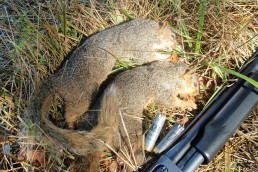Productive Squirrel Hunting
SHARE THIS POST
Walking the forest for squirrels is a fall delight, says John Bennett.
Over the past 60-some years, squirrel hunting for me has become more than a sport; it has become a passion. During these years, some tried-and-true techniques have emerged which, when used properly, greatly increase my odds for success.
Perhaps the greatest advice offered to would-be squirrel hunters, or to someone who wants to up his odds, would be to go hunting as many times as possible under as many conditions as possible. Finding two or three good woods and then hunting them thoroughly is a great help in becoming familiar with the squirrels and how they react to stormy weather; bright, sunny mornings; foggy, drizzly days; humid evenings; what time they emerge from their dens on frosty fall mornings; what months of the year they prefer leaf nests to den trees; and why they prefer oak, hickory and beech trees rather than elms and maples. Just sit, listen and watch, and you will learn much, whether you pull the trigger or not.
Squirrel hunting is more productive and a lot more fun when I hunt with a partner. It also makes it easier to resort to some of the old tricks which have become standard for squirrel hunters over the years. When one of us spots a bushytail frozen in place in the top of a tree, the other circles the tree, creating a racket, trying to cause the squirrel to move so that one us can take a shot.
One of us will work a call while the other studies the tree branches, looking for movement. Certainly, two pairs of eyes and ears are better than one in situations such as this. Finally, a partner can be a real help when it comes to locating a dead squirrel that has fallen to the leafy floor of a forest. I hate to waste game and I am reluctant to move on until a downed animal is found.
Since we don’t always stay together in the woods, my partners and I have worked out a series of bird calls and hand signals to let each other know where the other guy is. When I hear the whistle of a bobwhite, or see a guy move his hands, I know what he sees and hears, and whether I should move toward him or sit still.
I have hunted with one amigo on scads of river float hunts, which are fun and productive, but as of late we have set the boat aside in favor of a pair of hip boots and shotguns. We “wade hunt” nearby creeks and small streams. The techniques involved are similar to float hunting except that no boat is used.
Are you enjoying this post?
You can be among the first to get the latest info on where to go, what to use and how to use it!
After securing permission to park our vehicles and cross private land, we enter the water at a likely looking spot, move slowly and watch the trees for squirrels. By taking our time and choosing our steps carefully, we make less noise than we would in my small rowboat. Sometimes, we use two vehicles, parking one a mile or more upstream and wading to it. Or, sometimes we just wade for a while, then turn around and wade back. This is one of the big pluses in this type of hunting; we can simply walk out of a stream whenever we want to without struggling to pull a boat out of the water. Also, wading upstream is no problem, but trying to row a boat upstream can be a big problem.
The biggest plus is that we can get up close and personal with our prey. The creeks we wade are small and narrow which makes it easier to see, hear and shoot bushytails.
There is no perfect squirrel gun, though manufacturers strive to produce it, and my desire to find it keeps me looking through their catalogs. When we hunt a woods, I carry a Marlin model 49 .22 semi-auto, and my buddy John totes a sweet little Browning auto in .22. On a river or creek, we always carry shotguns chambered in either 12- or 16-gauge. Rifles are not practical since we usually are shooting up into the sky and have no way of knowing where a .22 bullet might land.
Our shotguns are stoked with shot shells in either #4 or #5 shot since a long shot may be required to fetch a squirrel out of the top of a tall tree. The heavier shot maintains enough sustained energy to complete the job.
Guns such as these serve us well and really are all that we need for successful and enjoyable hunting.
Want to make more informed choices when selecting your hunting gear? Get valuable information from the pros who know in the fall issues of MidWest Outdoors, available by subscribing on our website.
MWO
SHARE THIS POST
You may also like...
Nothing found.
Did you enjoy this post?
You can be among the first to get the latest info on where to go, what to use and how to use it!
John Bennett
John Bennett is a retired history teacher, historical re-enactor, father and grandfather. As a four-season outdoorsman, his passion is waterfowl hunting and fishing for smallmouth bass. He lives in Ohio and spends quite a bit of time in his primitive log cabin, which he built.
